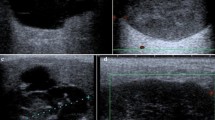Background
Over 20 years have passed since the development of endoscopic ultrasonography (EUS), and this technique is now widely used for the diagnosis of digestive and pancreaticobiliary diseases. EUS plays a number of roles in the clinical diagnosis of pancreatic tumors including detection of small tumors, differential diagnosis of tumors, and evaluation of tumor extent.
Methods
We evaluated the ability of EUS to detect pancreatic carcinoma in comparison with ultrasonography (US) and computed tomography (CT).
Results
The overall tumor detection rates were: US, 69%; CT, 79%; and EUS, 97%. With a tumor size smaller than 2 cm (TS1), the detection rate by EUS was as high as 100%, in contrast to 60% and 50% for US and CT, respectively, except for carcinoma in situ. However, EUS has some pitfalls. The EUS imaging technique is not always easy, EUS has limited penetration, and EUS alone cannot accurately differentiate malignancy from inflammation.
Conclusions
The following points are the future themes of EUS. (1) It will be necessary to foster a large number of operaters and to establish a standard EUS scanning technique. (2) Development of a new instrument with high resolution and deep penetration is anticipated. (3) Development of a new medium that can be infused into a vein and that allows diagnosis from B-mode images is much anticipated.
Similar content being viewed by others
Author information
Authors and Affiliations
About this article
Cite this article
Maguchi, H. The roles of endoscopic ultrasonography in the diagnosis of pancreatic tumors. J Hepatobiliary Pancreat Surg 11, 1–3 (2004). https://doi.org/10.1007/s00534-002-0752-4
Received:
Accepted:
Issue Date:
DOI: https://doi.org/10.1007/s00534-002-0752-4




